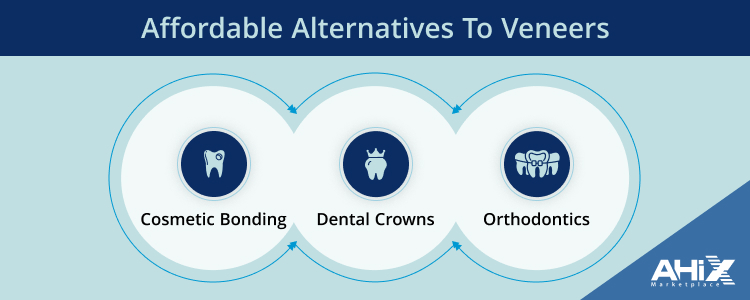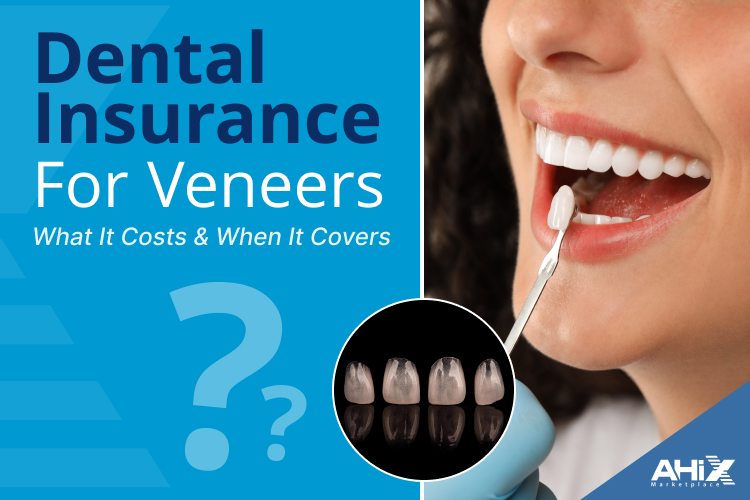Dental veneers are one of the most effective ways to improve a smile. They cover stained, chipped, or uneven teeth and provide a natural-looking result that can last for years. But with a single veneer costing up to $2,500, many people ask the same question: Is there dental insurance for veneers?
The short answer: usually not. Most dental insurance companies classify veneers as cosmetic and exclude them from coverage. Still, there are important exceptions, and even if your plan doesn’t pay, there are smarter ways to manage the cost.
This guide explains how dental insurance views veneers, when coverage might apply, what veneers typically cost, and alternative strategies for making treatment more affordable.
What Are Dental Veneers?

There are two main types of veneers:
- Porcelain veneers: Strong, stain-resistant, and long-lasting (10–15 years). They look very natural but cost more and require some enamel removal.
- Composite veneers: Made from a tooth-colored resin, they are more affordable and can be done in a single visit. However, they usually last only 5–7 years and may stain more easily.
Because veneers mainly improve appearance rather than restore dental function, most insurance companies treat them as elective procedures. This classification is why dental insurance for veneers is rarely included in standard plans.
Does Dental Insurance Cover Veneers?
In most cases, dental insurance for veneers is not included in standard plans. Insurance providers usually classify veneers as a cosmetic treatment, similar to whitening, and cosmetic services are generally excluded from coverage.
When Veneers Are Not Covered?
- Choosing veneers for a whiter smile
- Fixing small chips or gaps purely for cosmetic reasons
- Reshaping teeth to improve appearance
Exceptions: When Insurance Might Help
There are limited situations where veneers may qualify as medically necessary and therefore receive partial coverage:
- Accidents or trauma: If a tooth is fractured and a veneer restores its function
- Severe enamel erosion: When enamel loss causes pain or sensitivity
- Functional problems: If veneers improve chewing or speech in cases of significant structural damage
In such cases, your dentist must document the medical need with X-rays, photos, and a detailed treatment plan. Pre-authorization from the insurance company is almost always required before treatment.
Typical Costs of Veneers
Even with the best dental insurance for veneers, patients usually face significant out-of-pocket costs. Veneer prices vary depending on the material, dentist’s expertise, and the location.
- Porcelain veneers: $900–$2,500 per tooth. They are durable, natural-looking, and last 10–15 years with proper care.
- Composite veneers: $500–$1,500 per tooth. These are more affordable and can be placed in one visit, but typically last only 5–7 years.
- Full set (6–8 veneers): $6,000–$20,000 or more, depending on the clinic and city.
Because most dental insurance plans cap annual benefits between $1,000 and $2,500, even if veneers qualify for partial coverage, the insurance payout rarely covers more than one tooth.
Smarter Options if Insurance Won’t Cover Veneers
If your plan doesn’t include dental insurance for veneers, there are still ways to make treatment more affordable. Many patients combine financing tools and discount programs to reduce upfront costs.
1. Dental Office Payment Plans
Most dentists understand that veneers are a significant investment. Many clinics allow patients to spread payments across several months, sometimes with little or no interest.
2. Healthcare Credit Cards
Cards like CareCredit are designed for medical and dental expenses. They often provide promotional financing, including 0% interest if the balance is paid within a set time.
3. Health Savings Accounts (HSA) or Flexible Spending Accounts (FSA)
If veneers are considered medically necessary, you can use pre-tax dollars from these accounts, lowering your overall cost.
4. Dental Discount Plans
These membership-based programs are not insurance, but they can offer discounts of 20–60% on cosmetic and restorative treatments at participating providers.
5. Dental Schools
Veneers provided at dental schools are often done by supervised students, which can result in significantly reduced costs compared to private practices.
By exploring these smarter options, patients can achieve a confident smile even if their dental insurance doesn’t fully cover veneers.
What are Alternatives to Veneers?

If paying for veneers is out of reach and your dental insurance for veneers won’t help, there are more budget-friendly treatments that can still improve your smile.
Cosmetic Bonding
- Uses tooth-colored resin to repair chips, cracks, or small gaps.
- Cost: $300–$600 per tooth.
- Coverage: Sometimes included under basic restorative care.
- Downside: Less durable and can stain over time.
Dental Crowns
- A crown covers the entire tooth, making it stronger and restoring function.
- Cost: $800–$1,500 per tooth.
- Coverage: Often 50% covered under major restorative benefits.
- Best for: Teeth with significant decay or damage.
Orthodontics
- Braces or clear aligners can correct misalignment or spacing issues.
- Coverage: Some full dentalcoverage plans include partial orthodontic benefits.
- Best for: Patients seeking long-term alignment instead of cosmetic shells.
These alternatives may not give the same immediate cosmetic results as veneers, but they are more likely to be covered by insurance and may provide lasting functional benefits.
How AHiX Can Help You Compare Plans
Finding dental insurance for veneers can be tricky, but choosing the right plan still matters. Even if veneers aren’t fully covered, many insurance options help reduce costs for crowns, bonding, and other restorative treatments.
At AHiX, you can:
- Compare 600+ dental plans from more than 270 providers in one place.
- Check coverage details easily to see if a plan includes partial benefits for restorative care.
- Find affordable options, with dental plans starting as low as $8.95 per month.
- Get expert guidance, as licensed agents help you choose the plan that best fits your dental needs and budget.
By comparing different insurance plans through AHiX, you can maximize coverage for essential dental care and explore smarter ways to manage the cost of veneers or their alternatives.
Final Verdict: Is Dental Insurance for Veneers Worth It?
For most people, dental insurance for veneers is limited or unavailable because veneers are considered cosmetic. However, in rare cases where veneers restore function after trauma, enamel erosion, or other medical concerns, partial coverage may be possible.
Even if insurance doesn’t apply, you still have options. Financing plans, discount programs, HSAs or FSAs, and dental schools can make veneers more affordable. Plus, alternatives like bonding or crowns may achieve similar results with better insurance support.
The bottom line: Veneers are an investment in both confidence and oral health. By comparing dental plans with AHiX, you can make smarter choices, reduce costs for other treatments, and find a plan that supports your long-term dental care goals.
FAQs
1. Does dental insurance usually cover veneers?
No. Most dental insurance plans do not cover veneers because they are considered cosmetic. However, some policies may provide partial coverage if veneers are needed to restore function after trauma, severe enamel erosion, or structural tooth problems.
2. In what cases will insurance pay for veneers?
Insurance may help cover the cost of veneers when they are medically necessary. Examples include repairing a broken tooth after an accident, correcting enamel defects that cause sensitivity, or restoring proper chewing function. In these cases, your dentist must document the medical need and submit it to your insurer for approval.
3. How much do veneers cost without dental insurance?
Porcelain veneers usually cost between $900 and $2,500 per tooth, while composite veneers range from $500 to $1,500. A full set of veneers for 6–8 teeth can cost $6,000 to $20,000 or more, depending on location and materials.
4. What are some affordable alternatives to veneers?
Alternatives include dental bonding, crowns, and orthodontic treatments. Bonding is the least expensive and can fix small chips or gaps. Crowns are often covered partly by insurance if the tooth is damaged. Orthodontics may also be covered if correcting bite issues.
5. How can I pay for veneers if my insurance won’t cover them?
Patients often use dental office payment plans, CareCredit or other medical credit cards, pre-tax dollars from an HSA or FSA, dental discount programs, or treatment at dental schools to reduce costs. These options make veneers more manageable even without insurance coverage.
6. Can I buy a special dental insurance plan just for veneers?
No standard dental insurance plan is designed just for veneers. Some premium or full-coverage plans may offer limited benefits for restorative cases, but cosmetic veneers are almost never fully covered.
7. Do PPO or HMO dental plans cover veneers better?
PPO plans sometimes provide partial out-of-network benefits if veneers are medically necessary, while HMO plans are more restrictive. In both cases, cosmetic veneers are generally excluded.
8. Can I use my HSA or FSA to pay for veneers?
Yes, if your dentist proves that veneers are medically necessary. If they are cosmetic only, you usually cannot use HSA or FSA funds. Always check with your plan administrator first.
9. Are veneers ever covered if they replace a crown or filling?
Sometimes. If a crown or large filling has failed, and a veneer is the least invasive way to restore the tooth, insurance may cover part of the cost. Documentation and pre-authorization are required.
10. How long do veneers last, and will insurance cover replacements?
Porcelain veneers last 10–15 years, and composite veneers last 5–7 years. Insurance may cover replacement only if the original veneer was placed for medical reasons and enough years have passed under your plan’s replacement rules.
11. Is dental bonding or a crown more likely to be covered than veneers?
Yes. Bonding and crowns are often considered restorative treatments, which means many insurance plans will pay 50–80% of the cost. Veneers, by contrast, are usually classified as cosmetic.
12. What’s the best way to check if my plan covers veneers?
Start by reviewing your plan’s Summary of Benefits and look for “cosmetic exclusions.” Then call your insurance provider directly and ask about procedure code D2962 (porcelain laminate veneers). Request a pre-treatment estimate for clear confirmation.



